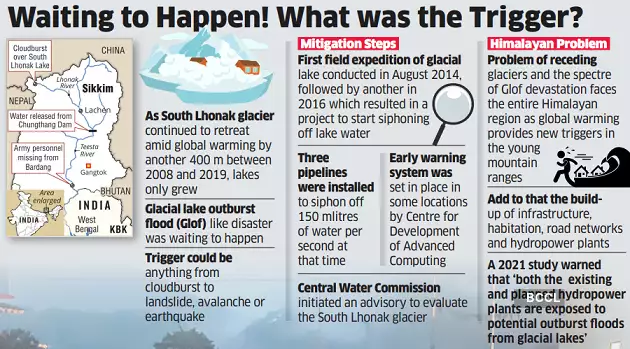Geography
Glacial Lake Outburst Flood in Sikkim
- 07 Oct 2023
- 6 min read
For Prelims: Glacial Lake Outburst Flood, Teesta River, Indian Himalayan Region, Climate change, National Disaster Management Authority, Avalanche
For Mains: Factors Responsible for GOF and Measures to Mitigate the Risk, Important Geophysical Phenomena.
Why in News?
Sikkim recently experienced a Glacial Lake Outburst Flood (GLOF). The South Lhonak Lake, a glacial lake located at an altitude of 17,000 feet in the state's northwest, experienced a rupture as a result of continuous rainfall.
- Consequently, water was discharged into the downstream regions, causing flooding in the Teesta River and impacting four districts of Sikkim: Mangan, Gangtok, Pakyong, and Namchi, as reported by the Sikkim State Disaster Management Authority (SSDMA).
- This flooding also caused the Chungthang Hydro-Dam in Sikkim (on Teesta river) to breach, worsening the overall situation.
What is Glacial Lake Outburst Flood?
- About:
- A GLOF (Glacial Lake Outburst Flood) is a sudden and potentially catastrophic flood that occurs when water stored behind a glacier or a moraine (a natural accumulation of ice, sand, pebbles, and debris) is released rapidly.
- These floods happen when glacial lakes formed by melting ice accumulate water behind weak moraine dams.
- Unlike sturdy earthen dams, these moraine dams can fail abruptly, releasing large volumes of water in minutes to days, leading to devastating downstream flooding.
- The Himalayan terrain, with its steep mountains, is particularly vulnerable to GLOFs.
- Climate change, accompanied by rising global temperatures, has expedited the process of glacier melting in the Sikkim Himalayas.
- The region now boasts more than 300 glacial lakes, with ten identified as susceptible to outburst floods.
- Climate change, accompanied by rising global temperatures, has expedited the process of glacier melting in the Sikkim Himalayas.
- GLOF can be triggered by several reasons, including earthquakes, extremely heavy rains and ice avalanches.
- A GLOF (Glacial Lake Outburst Flood) is a sudden and potentially catastrophic flood that occurs when water stored behind a glacier or a moraine (a natural accumulation of ice, sand, pebbles, and debris) is released rapidly.
- Impact:
- GLOFs can result in catastrophic downstream flooding. They have the potential to release millions of cubic meters of water in a short period of time.
- Peak flows during GLOFs have been recorded as high as 15,000 cubic meters per second (as per National Disaster Management Authority).
- GLOFs can result in catastrophic downstream flooding. They have the potential to release millions of cubic meters of water in a short period of time.
How Susceptible is South Lhonak Lake to GLOFs?
- The South Lhonak lake in northern Sikkim is situated about 5,200 meters above sea level.
- Scientists have previously warned that the lake had been expanding over years, possibly from the melting of the ice at its head.
- Notably, seismic activities, including a 2011 magnitude 6.9 earthquake, escalated the GLOF risk in the area.
- In 2016, the Sikkim State Disaster Management Authority and other stakeholders launched a critical plan to drain excess water from South Lhonak Lake.
- Visionary innovator Sonam Wangchuk led the effort, employing High Density Polyethylene (HDPE) pipes to siphon off water from the lake.
- This initiative successfully reduced the lake's water volume by approximately 50%, mitigating the risk to some extent.
- However, the recent tragedy is believed to be caused by an avalanche originating from the ice-capped feature surrounding the lake.
What are the Other Recent GLOF Incidents in India?
- In June 2013, Uttrakhand had received an unusual amount of rainfall leading to the melting of the Chorabari glacier and the eruption of the Mandakini river.
- In August 2014, a glacial lake outburst flood hit the village of Gya in Ladakh
- In February 2021, Chamoli district in Uttarakhand witnessed flash floods which are suspected to have been caused by GLOFs.
What Actions be Taken to Reduce the Risk of GLOFs?
- Glacial Lake Monitoring: Establishing a comprehensive monitoring system to track the growth and stability of glacial lakes in vulnerable regions.
- Satellite imagery, remote sensing technology, and field surveys through drones can be used to regularly assess changes in glacial lakes and their associated moraine dams.
- Early Warning Systems: and early warning systems that can provide timely alerts to downstream communities in the event of a GLOF.
- Also, there is a need to complement it with flood protection measures, such as constructing protective barriers, levees, or diversion channels to redirect floodwaters away from populated areas.
- Public Awareness and Education: There is a need to raise public awareness about the risks of GLOFs and educate communities living downstream about evacuation procedures and safety measures, as per NDMA’s guidelines related to GLOF.
- Conduct drills and training programs to ensure that residents know how to respond in case of a GLOF.
- International Cooperation: India can collaborate with neighboring countries in the Himalayan region, as GLOFs can have transboundary impacts.
- Sharing information and best practices for GLOF risk reduction and management with neighboring countries can help to mitigate the risk.







